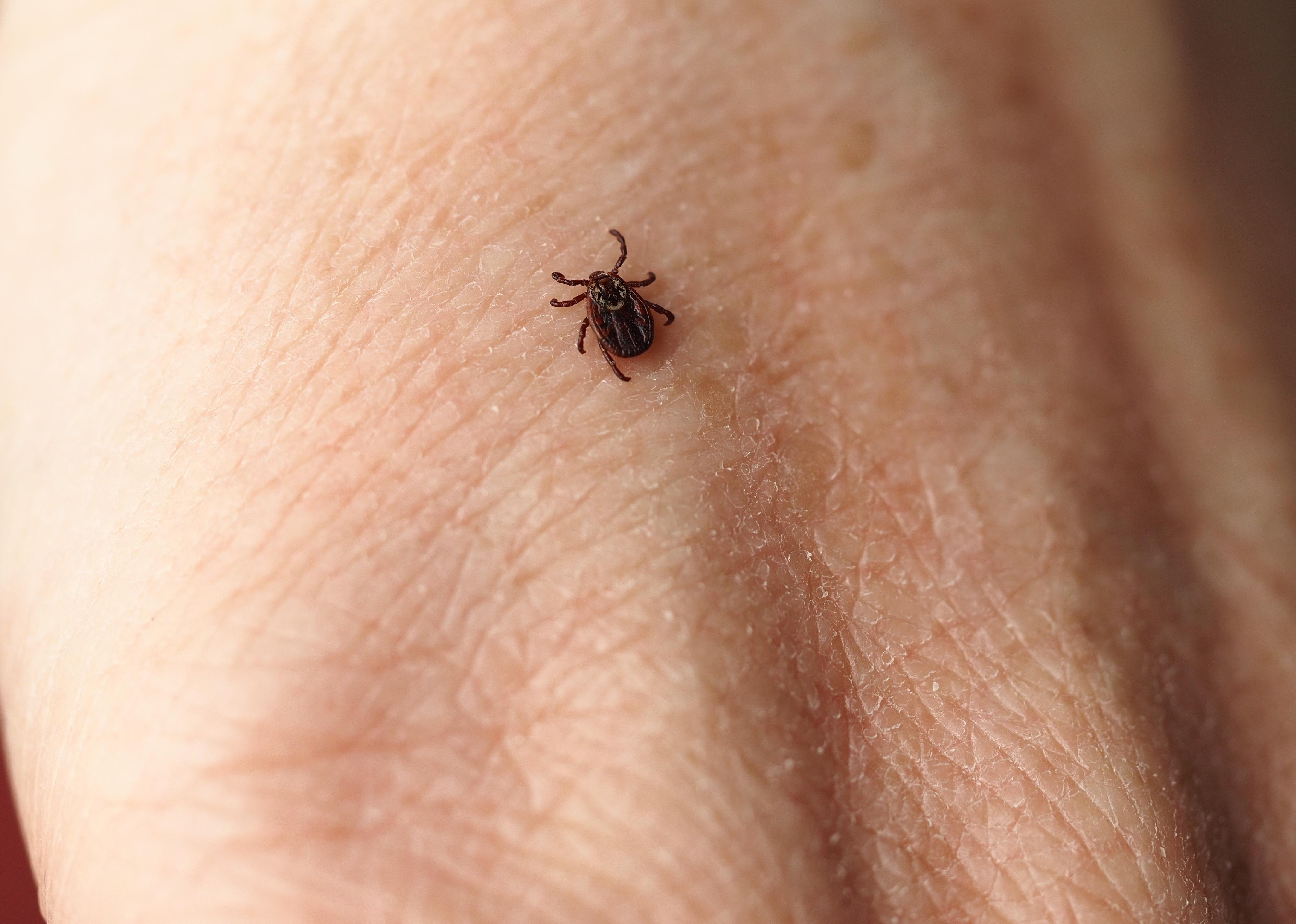
11 tick-borne illnesses and what to watch out for during your outdoor adventures
11 tick-borne illnesses and what to watch out for during your outdoor adventures
There are numerous species of ticks, fewer than 10 of which are known to bite humans.
These small, blood-sucking insects can be found everywhere in the United States except Alaska, though they are more common in mountainous and tropical areas with lush vegetation. Not all diseases transmitted by ticks are life-threatening; however, when left untreated, some can become fatal.
Stacker compiled a list of 11 common tick-borne diseases in the U.S. and what symptoms to watch out for as the weather warms using a variety of medical and government sources.
Ticks have spider-like bodies and frequent areas with tall grass, logs, bushes, trees, and fallen leaves. Once they bite, they start feeding and engorging with the host's blood. They can remain attached for several days, and the longer they feed, the higher the risk of transmitting bacteria, viruses, parasites, or pathogens to their host, causing tick-borne diseases.
The zoonosis—or infections transmitted from animals to humans—caused by ticks can be prevented by using tick repellent when outdoors, especially from spring to fall when they are more active. In warmer states, they can be found all year long. After being outside or near animals, check for ticks after you return indoors since the bites cannot be felt. If you find one, remove it immediately with tweezers. Apply the same process with pets and small children.
Keep reading to learn more about 11 tick-borne illnesses.

Lyme disease
Lyme disease is a bacterial infection spread to humans from squirrels, mice, or other small mammals by ticks contaminated with Borrelia burgdorferi. It is the most common infection caused by tick bites in the U.S.; so named for the Connecticut town where the disease was first documented and studied.
Each year, more than 30,000 people are diagnosed with Lyme disease. Treatment is more effective the earlier it is applied. Visit a doctor if you have recently been in grassy areas or forests, have an oval shape rash, and present symptoms similar to the flu: fever, shivers, muscle pain, and headaches.

Babesiosis
Some patients might not show symptoms at all when infected with babesiosis, others might confuse it with the flu; however, when the parasitic infection goes undiagnosed for several weeks, life-threatening conditions can arise.
Complications may include low blood pressure, kidney, liver, or heart failure, and hemolytic anemia. Babesiosis often appears in patients infected with Lyme disease.

Ehrlichiosis
If bitten by a tick, be sure to look out for flu-like symptoms plus confusion, diarrhea, nausea, vomiting, and loss of appetite, they might indicate having ehrlichiosis.
When left untreated with antibiotics, the infection can cause nerve or brain damage, respiratory failure, uncontrolled hemorrhage, organ failure, and even death. A rash is common in infected children. Infants, seniors, and people with compromised immune systems are at greater risk of developing severe, life-threatening symptoms.

Rocky Mountain spotted fever
The bacterium Rickettsia rickettsii—transmitted through tick bites—can cause Rocky Mountain spotted fever. Although more cases are reported in warmer months, RMSF can appear all year long. Males over 40, and people with a weakened immune system are at higher risk of infection and complications.
When misdiagnosed or left untreated, RMSF symptoms include those similar to the flu and stomach viruses, along with rashes, leaking blood vessels, excess fluid in tissues, and damaged muscles, nerves, and organs.

Anaplasmosis
Symptoms of anaplasmosis can start one or two weeks after a tick infected with the Anaplasma phagocytophilum bacteria bites an individual. Initial symptoms are similar to those from other tick-borne diseases, while complications can cause confusion, seizures, excess bleeding, heart and kidney failure, respiratory crash, septic shock, and coma.
Anaplasmosis is spread by deer ticks and Western black-legged ticks.

Southern Tick-Associated Rash Illness
The cause of the infection known as STARI is unknown. One of the first symptoms is a rounded rash similar to the one that appears with Lyme disease. The infection can provoke symptoms ranging from fatigue to muscle pain. STARI can only be diagnosed on the basis of symptoms and geographic location; no blood tests can confirm the infection. It is transmitted by the Lone Star tick, found in central Texas, Oklahoma, the southern states, and up along the Atlantic Coast.

Tick-borne relapsing fever
Tick-borne relapsing fever is caused by various species of spiral-shaped bacteria or spirochaetes transmitted to humans through the bites of infected soft ticks. In the U.S., the most common bacteria causing TBRF is Borrelia hermsii.
Symptoms include high fever, headaches, and muscle and joint pain, which appear in cycles of 2 to 7 days and then disappear for 4 to 14 days. Without treatment, this cycle can repeat several times. TBRF outbreaks have been linked to stays in rustic cabins in national parks or reserves, mainly in the mountainous areas of the westernmost states.

Tularemia
Tularemia is an infection typically found in squirrels, wild rodents, certain birds, and rabbits. It's a rare disease that affects no more than 200 people per year in the U.S. Aside from ticks, mosquitoes, and deer flies can also transmit the bacteria that causes the illness: Francisella tularensis.
Symptoms may differ widely, from none or very mild to life-threatening, and they depend on the type of tularemia the patient develops. It can be glandular, pneumonic, oculoglandular, oropharyngeal, and typhoidal.

Colorado tick fever
Most cases of Colorado tick fever appear in spring, in the western U.S., at elevations of 4,000 feet and above. In very rare cases, the virus can be transmitted by blood transfusions, though most are caused by Rocky Mountain wood tick bites.
On-and-off episodes of fever are commonly the first symptom, followed by weakness, headache behind the eyes, sleepiness or confusion, light-colored rashes, photophobia, nausea, and vomiting. There is no known treatment for CTF, most patients present mild symptoms and recover on their own.

Powassan Encephalitis
Powassan encephalitis is a rare, tick-borne virus carried by the black-legged or deer tick, the same kind that can spread Lyme disease, anaplasmosis, and babesiosis. Cases occur mainly in the northeastern United States during the warmer months. Flu-like symptoms are the first to appear, followed by seizures, encephalitis, and meningitis in more severe cases. Ten percent of people with severe cases of the disease die, and about half of survivors report having long-lasting symptoms, such as "recurring headaches, loss of muscle mass and strength, and memory problems."

Q fever
The infectious disease Q fever is spread by inhalation, ingestion, or transmission of the Coxiella burnetii bacterium that lives in farm, domestic, and wild animals. Farm and slaughterhouse workers and veterinarians are particularly vulnerable to the disease. Mild symptoms can appear about two weeks after infection, though more serious signs—high fever, eye, and respiratory tract infection, and severe headaches—can show up suddenly several weeks later in about 5% of cases. If Q fever turns chronic, the patient's heart, liver, and other vital organs can be compromised. It is treated with antibiotics, though affected heart valves may need surgery.



